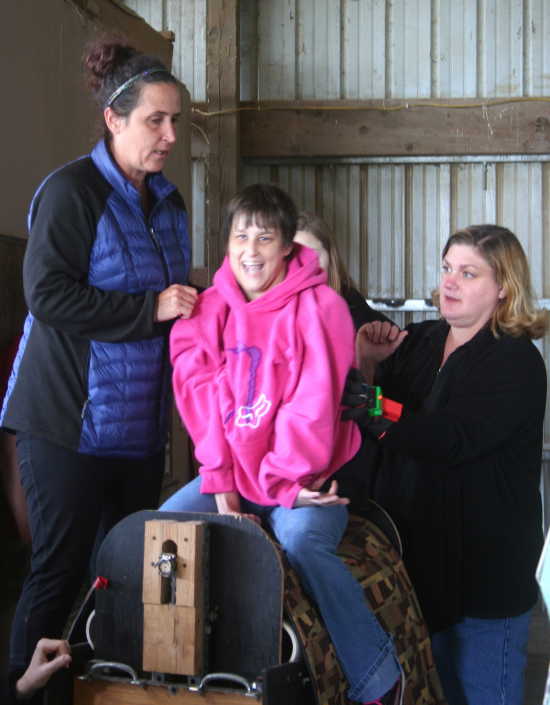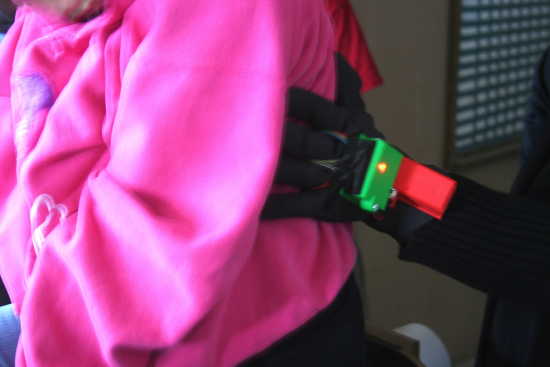Horses, tech and therapy

Innovation and therapy came together in a unique way when Rose-Hulman students presented their inventions to the staff, friends and patients of Hope Haven Horse Farm on Sunday.
"I'm so excited about this," Christy Menke, the owner and operator, said. "I'm like a kid in a candy store. I want the focus to be on the students. This is their day."
Three student teams presented four projects, all designed to make the distinct form of therapy practiced at Hope Haven more scientific and measurable. The horse farm serves as an opportunity for the mentally handicapped to have a little fun while also building muscle and perfecting balance.

"They may be resistant to therapy in a clinic," Penny Rogers, a frequent volunteer, said, "but you put them on a horse and they're having fun, they get less resistant. A horse mimics the way a person walks, so it strengthens their muscles too. The riders form extreme bonds with the horses...the horses get attached to the riders."
As the rider sits on the horse, one volunteer leads the horse while two more serve as "sidewalkers."
"It takes a real team," Stephanie Griffin, a PATH certified riding instructor, said.

The teamwork atmosphere is evident at Hope Haven. Since the farm tries to keep the same volunteers to the same rider, patients also get attached to the volunteers. And as the riders tested the new equipment, family members and volunteers cheered for them.
"They love it," Griffin said. "Coming out here is a big deal to them. When they come out, this is their day. It helps them thrive."
Hope Haven currently serves 20 consistent patients, and had been using subjective terms to measure a patient's progress in balancing on the horse and using the reins correctly. But that's where the students came in.

Senior biomedical engineers Evan Deckard, Brandon Bullitt, Hallie Drake and Katie Ray created a device that attaches to the stirrups and measures the pressure a rider puts on each side. Knowing this will help Menke and her volunteers tell whether a patient's balance is improving over time.
Having been working on the project since September, the group spent $3,500 to make the device, but say that it could be manufactured for $3,150. Their project was funded by an anonymous donor, and they don't plan to patent their designs.
"Our main goal was to get this done, for something they could use now," Ray said.

Drake added, "We wanted to make it simple enough for someone else to manufacture."
Another group, called Make It Happen, "completely remodeled" the Johnny Five machine created by other Rose-Hulman students in 2012. The machine mimics the movements of a horse, which makes horseback riding much easier to teach and learn.
"We've been having a lot of fun with this project," Ray Fleener, a junior mechanical engineering major, said. "This project just allowed us to branch out."
He worked with Lisa Lillis, a senior mechanical engineer, and Aaron Jones, a junior mechanical engineer, but the three also had help from biomedical and electrical engineers.
"The old one wasn't very sturdy, and it wasn't designed with future improvements in mind," Lillis said. "We thought there was a better way to do it."
So the team designed new sensors to measure the rein pressure a patient is using. But they aren't done yet.
"I'm excited to see the finished product," Lillis said, adding that it should be done in two weeks.
From another group of biomedical engineers, Milan Thakker, Michael Frondorf, Jacob Hiday and John Masters made a "force glove" that tells how much force a staff member is using -- or, hopefully, isn't -- to stabilize a rider on the Johnny Five. They also created a "spring step," which gauges the force a rider places on their feet while practicing on the Johnny Five.
"There's nobody doing this," Menke said. "We are trying to break this barrier and show that technology can be used for this."
A lot of progress was made that day, but Menke stills sees ways to move ahead, like synchronizing a GoPro camera with the devices so she knows exactly what was happening at a particular moment in the data.
"I think (other people's excitment) makes it so much better," Drake said. "I'm excited to see what other people do with it."
